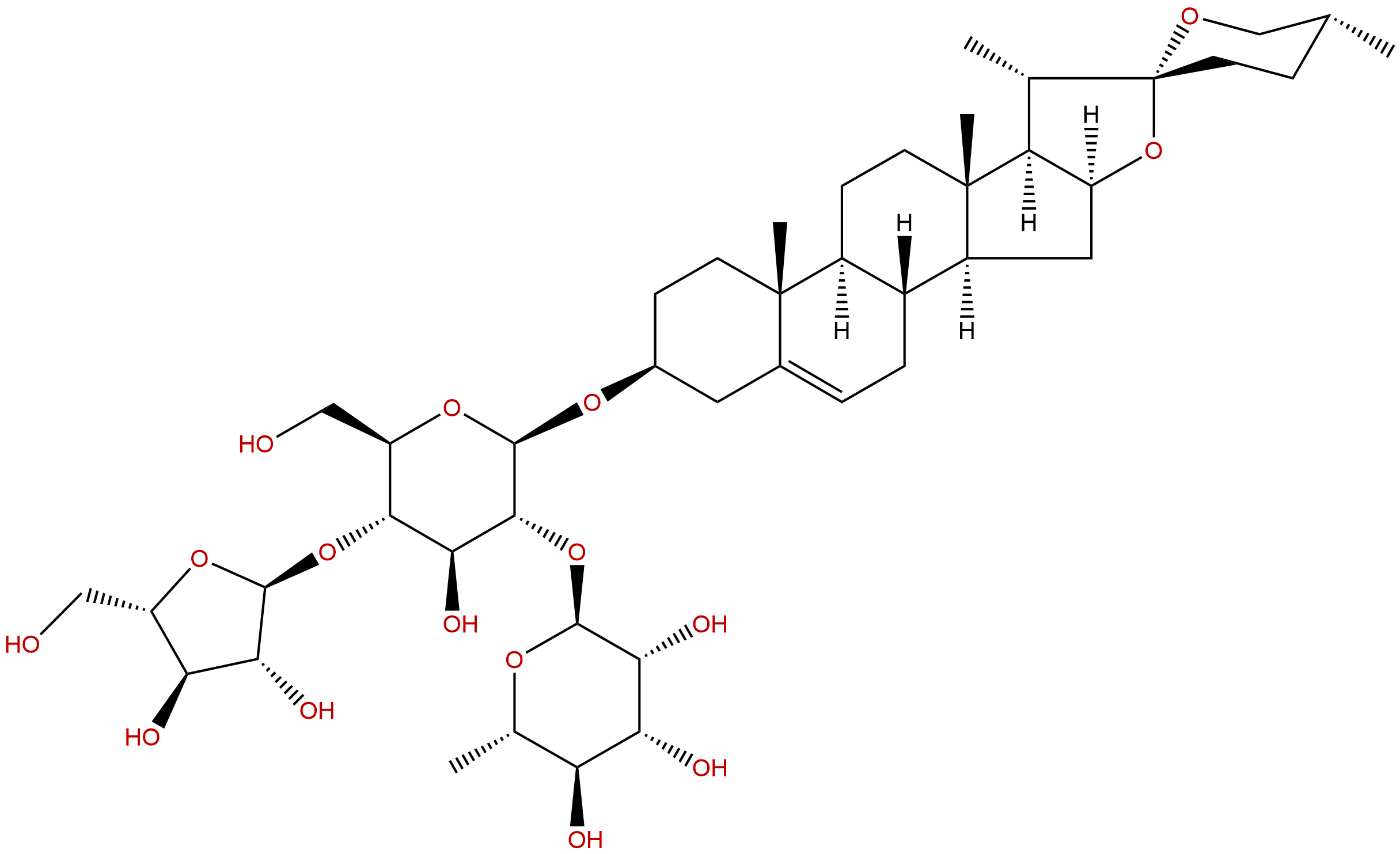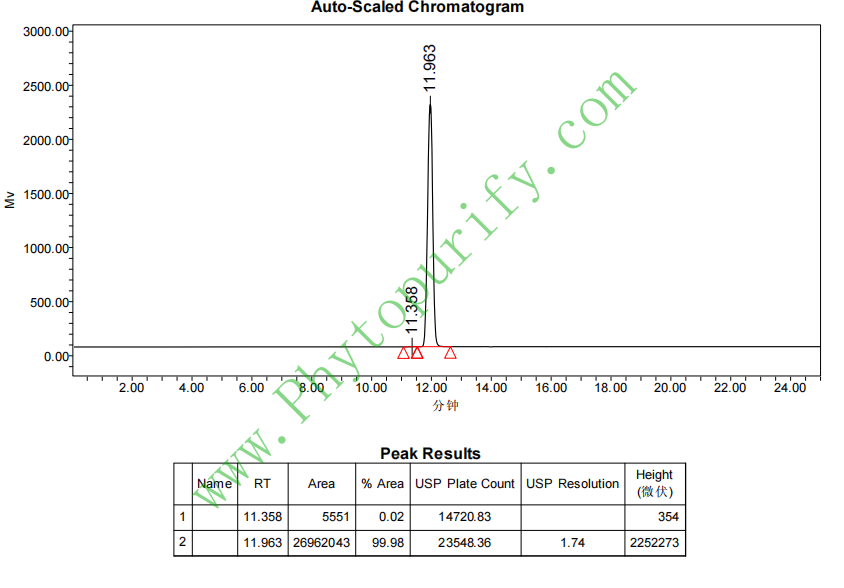
Polyphyllin ICAS No.:50773-41-6
|
||||||||||
 |
|
|
||||||||

| Catalogue No.: | BP3323 |
| Formula: | C44H70O16 |
| Mol Weight: | 855.028 |
Product name: Polyphyllin I
Synonym name:
Catalogue No.: BP3323
Cas No.: 50773-41-6
Formula: C44H70O16
Mol Weight: 855.028
Botanical Source:
Physical Description: Powder
Type of Compound: Steroids
Purity: 95%~99%
Analysis Method: HPLC-DAD or/and HPLC-ELSD
Identification Method: Mass, NMR
Packing: Brown vial or HDPE plastic bottle
The product could be supplied from milligrams to grams. Inquire for bulk scale.
We provide solution to improve the water-solubility of compounds, thereby facilitating the variety of activity tests and clinic uses.
For Reference Standard and R&D, Not for Human Use Directly.
Description:
Polyphyllin D has anti-angiogenic, and anticancer effects, it induces apoptosis via the mitochondrial apoptotic pathway as evidenced by decreased Bcl-2 expression levels, disruption of MMP and increased Bax, cytochrome C and cleaved-caspase-3 levels.Polyphyllin D has toxicity in human RBCs as well as its underlying mechanism for the hemolysis and eryptosis/erythroptosis.
References:
J Pharm Pharmacol. 2014 May;66(5):713-21.
Polyphyllin D induces apoptosis in K562/A02 cells through G2/M phase arrest.
The effect of Polyphyllin D on inducing cell death of the K562/A02 human leukaemia drug-resistant cells in vitro was examined.
METHODS AND RESULTS:
The effect of Polyphyllin D on K562/A02 cells were analysed by studying their cytotoxicity, apoptosis, cell cycle distribution, caspase-3 activity and disruption of mitochondrial membrane potential (MMP). Polyphyllin D, a small molecular monomer extracted from rhizoma of Paris polyphyllin, exhibited strong anticancer activity in a previous study. Our results demonstrate that Polyphyllin Dexerts a growth inhibitory effect by arresting cells at G2/M phase and by the induction of apoptosis in K562/A02 human leukaemia drug-resistant cells, G2/M phase arrest was found to be associated with up-regulation of p21 and down-regulation of cyclin B1 and cyclin-dependent protein kinase 1. Polyphyllin D-induced apoptosis via the mitochondrial apoptotic pathway as evidenced by decreased Bcl-2 expression levels, disruption of MMP and increased Bax, cytochrome C and cleaved-caspase-3 levels.
CONCLUSIONS:
These data suggest that Polyphyllin D has a potential as a potent therapeutic agent for chronic myeloid leukaemia.
Arch Toxicol. 2012 May;86(5):741-52.
Polyphyllin D induces apoptosis in human erythrocytes through Ca²⁺ rise and membrane permeabilization.
Polyphyllin D (PD) is a potent anticancer agent isolated from a traditional medicinal herb Paris polyphylla that has been used in China for many years to treat cancer. Polyphyllin D is not a substrate of p-glycoprotein, and it can bypass the multi-drug resistance in cancer cell line R-HepG2. However, the effect of Polyphyllin D on the induction of cell death in human erythrocytes remains unknown. Given that Polyphyllin D is a small molecule that can depolarize the mitochondrial membrane potential and release apoptosis-inducing factor (AIF) in isolated mitochondria, we hypothesized that the apoptogenic effect of Polyphyllin D in human erythrocytes devoid of mitochondria would be minimal. This study therefore tried to evaluate the in vitro effect of Polyphyllin Don hemolysis and apoptosis in human erythrocytes.
METHODS AND RESULTS:
Apoptosis in human red blood cells (RBCs), also known as eryptosis or erythroptosis, after Polyphyllin D treatment was determined by flow cytometry and confocal microscopy for the phosphatidyl-serine externalization and other apoptosis feature events. False to our prediction, Polyphyllin D caused hemolysis and eryptosis/erythroptosis in human RBCs. Mechanistically, elevation in the cytosolic Ca²⁺ ion level seems to be a key but not the only mediator in the Polyphyllin D-mediated eryptosis/erythroptosis because depletion of the external Ca²⁺ could not eliminate the Polyphyllin D effect. Also, Polyphyllin D was able to permeabilize the membrane of RBC ghosts in a way similar to digitonin.
CONCLUSIONS:
Taken together, we report here for the first time the toxicity of Polyphyllin D in human RBCs as well as its underlying mechanism for the hemolysis and eryptosis/erythroptosis.
J Ethnopharmacol. 2011 Sep 1;137(1):64-9.
Polyphyllin D, a steroidal saponin from Paris polyphylla, inhibits endothelial cell functions in vitro and angiogenesis in zebrafish embryos in vivo.
Angiogenesis, the process of blood vessel formation, is critical to tumour growth. The importance of angiogenesis in tumour development has lead to the development of anti-angiogenic strategies to inhibit tumour growth. In this study, Polyphyllin D (PD), an active component in Chinese herb, Paris polyphylla, was evaluated for its potential anti-angiogenic effects.
METHODS AND RESULTS:
The inhibitory effects of Polyphyllin D on three important processes involved in angiogenesis, i.e. proliferation, migration and differentiation were examined using human microvascular endothelial cell line HMEC-1 by MTT assay, scratch assay and tube formation assay, respectively. Using zebrafish embryos as an animal model of angiogenesis, the anti-angiogenic effect of Polyphyllin D was further verified in vivo. Polyphyllin D suppressed the growth of HMEC-1 cells at 0.1-0.4 μM without toxic effects. At 0.3 μM and 0.4 μM, Polyphyllin D significantly inhibited endothelial cell migration and capillary tube formation. About 70% of the zebrafish embryos showed defects in intersegmental vessel formation upon treatment with Polyphyllin D at concentrations of 0.156 μM and 0.313 μM.
CONCLUSIONS:
The anti-angiogenic effects of Polyphyllin D have been explored in the study which implied a potential therapeutic development of Polyphyllin D in cancer treatment.
HPLC of Polyphyllin I
